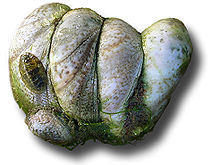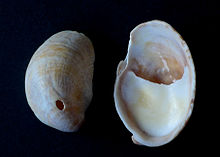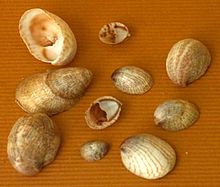- Common slipper shell
-
Common slipper shell 
A live but washed-up stack of Crepidula fornicata with a small chiton on the left; the lowest individual (on the right of this stack) would have been fixed to a hard surface. Scientific classification Kingdom: Animalia Phylum: Mollusca Class: Gastropoda (unranked): clade Caenogastropoda
clade HypsogastropodaOrder: Littorinimorpha Superfamily: Calyptraeoidea Family: Calyptraeidae Genus: Crepidula Species: C. fornicata Binomial name Crepidula fornicata
(Linnaeus, 1758)The common slipper shell, Crepidula fornicata, has many other common names including common Atlantic slippersnail, boat shell, quarterdeck shell, fornicating slipper snail, and it is known in Britain as the "common slipper limpet". This is a species of medium-sized sea snail, a marine gastropod mollusc in the family Calyptraeidae, the slipper snails and cup and saucer snails.
Contents
Description
The size of the shell is 20-50 mm.[1] The maximum recorded shell length is 56 mm.[2]
This sea snail has an arched, rounded shell. On the inside of the shell there is a white "deck" which causes the shell to resemble a boat or a slipper, hence the common names. Some of these may be flat, slightly arched, or arched heavily. The 'Flat slipper shell' is also another type of slipper shell.
Distribution
The species is native to the western Atlantic Ocean, specifically the Eastern coast of North America. It has been introduced accidentally to other parts of the world and has become problematic.
Distribution of Crepidula fornicata ranges from 48°N to 25°N; 97.2°W to 25°W[1] from as far north as Nova Scotia to as far south as the Gulf of Mexico.[1]
Nonindigenous distribution
 Two beachworn shells of Crepidula fornicata from North Wales
Two beachworn shells of Crepidula fornicata from North Wales
It was introduced to the state of Washington.[1] The species was however brought to Europe together with the eastern oyster Crassostrea virginica.[1] In Belgium, the first slipper limpet was found on 28 September 1911 attached to an oyster in Ostend and since the 1930’s, it is seen as a common species along Belgian coast.[1]
The species is considered an invasive species in Denmark, France, Italy, the Netherlands, Spain, and the UK, and has also spread to Norway and Sweden.[3] It is known to damage oyster fisheries.[4] The slipper limpet has little to no predators in Europe, and can thrive on several types of hard bottoms and shellfish banks.[1] A continued expansion to the north is probably inhibited by temperature: low temperatures during the winter can slow down or inhibit the development of the slipper limpet.[1]
It has also been introduced to the Pacific Northwest and Japan.[5]
Ecology
Habitat
This is a common snail, usually found intertidally, infralittoral and circalittoral and in estuaries.[1]
Minimum recorded depth is 0 m.[2] Maximum recorded depth is 70 m.[2]
They are often found, sometimes living stacked on top of one another, rocks,[1] on horseshoe crabs, shells and on dock pilings.
Feeding habits
Generally for Calyptraeidae, feeding habits include planktonic and minute detrital food items through either suspension or deposit feeding.[1]
Life cycle
The species is a sequential hermaphrodite. The largest and oldest animals, at the base of a pile are female, the younger and smaller animals at the top are male. If the females in the stack die, the largest of the males will become a female.[6]
References
This article incorpoates CC-BY-SA-3.0 text from the reference [1]
- ^ a b c d e f g h i j k l Gofas, S. (2010). Crepidula fornicata (Linnaeus, 1758). In: Bouchet, P.; Gofas, S.; Rosenberg, G. (2010) World Marine Mollusca database. Accessed through: World Register of Marine Species at http://www.marinespecies.org/aphia.php?p=taxdetails&id=138963 on 2011-01-13
- ^ a b c Welch J. J. (2010). "The “Island Rule” and Deep-Sea Gastropods: Re-Examining the Evidence". PLoS ONE 5(1): e8776. doi:10.1371/journal.pone.0008776.
- ^ Global Invasive Species Database
- ^ Joint Nature Conservation Committee
- ^ Marine Life Information Network for Britain and Ireland
- ^ Global Invasive Species Database
External links
- Common Atlantic slipper shell:Master/Mistress of Metamorphosis
- Gould A. A. (1870). Report on the Invertebrata of Massachusetts. page 271.
Categories:
Wikimedia Foundation. 2010.

